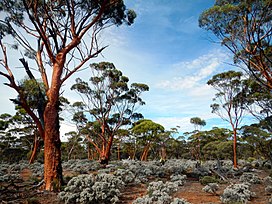Coolgardie woodlands
| Coolgardie woodlands | |
|---|---|
 Eucalyptus woodlands near Norseman, Western Australia | |
 Ecoregion territory (in red) | |
| Ecology | |
| Realm | Australasian |
| Biome | Mediterranean forests, woodlands, and scrub |
| Borders | List
|
| Geography | |
| Area | 140,001 km2 (54,055 sq mi) |
| Country | Australia |
| States | Western Australia |
| Coordinates | 31°46′S 121°44′E / 31.77°S 121.74°E |
| Conservation | |
| Conservation status | Critical/endangered |
| Protected | 16,323 km2 (12%)[1] |
The Coolgardie woodlands is an ecoregion in southern
Location and description
The Coolgardie woodlands is part of the Mediterranean-climate Southwest Australia biogeographic region, whose forests, woodlands, and shrublands are globally noteworthy for their diversity of plant species.
The Coolgardie woodlands ecoregion consists of two
The Hampton region is coastal, lying southeast of the Coolgardie region on the shore of the Great Australian Bight. It is bounded on the north and east by the Nullarbor Plains xeric shrublands.[2]
Flora
The ecoregion is home to several plant communities, including eucalyptus woodlands and shrublands of mallee and acacia. Woodlands of Salmon gum (Eucalyptus salmonophloia) and gimlet (Eucalyptus salubris) are common in central Coolgardie, generally on rolling plains and river valleys on red loam soils over red clay. Salmon gums reach 15-20 meters in height, and gimlet a height of 8 to 12 meters. The woodlands are open and irregular, and with an understory of low shrubs (including Maireana sedifolia and Atriplex spp.), herbs, and grasses.[6]
Protected areas
A 2017 assessment found that 16,323 km2, or 12%, of the ecoregion is in protected areas – 14,731 km2 (11%) of the Coolgardie region and 1,592 km2 (15%) of the Hampton region.
The coastal Nuytsland Nature Reserve covers the western portion of the Hampton region, and Nullarbor National Park covers its easternmost portion.
See also
External links
- "Coolgardie woodlands". Terrestrial Ecoregions. World Wildlife Fund.
References
- ^ PMID 28608869.) Supplemental material 2 table S1b.
{{cite journal}}: CS1 maint: date and year (link - ^ a b "Coolgardie woodlands". Terrestrial Ecoregions. World Wildlife Fund.
- ^ "Map of Ecoregions 2017". Resolve. Retrieved August 20, 2021.
- ^ "Coolgardie woodlands". Digital Observatory for Protected Areas. Retrieved August 20, 2021.
- ^ "Coolgardie woodlands". The Encyclopedia of Earth. Retrieved August 20, 2021.
- ^ Elith, Jane and Sjaan Bidwell (2004). Identification and Assessment of Nationally Threatened Woodlands. Description of Ecological Communities: Arid Eucalypt Woodlands. Report to the Commonwealth Department of the Environment and Heritage, 2004.
- ^ Ley, Sussan (October 4, 2020). "Indigenous Protected Areas expanded by 7 million hectares". Australian Government. Government of Australia. Retrieved 2022-05-12.
